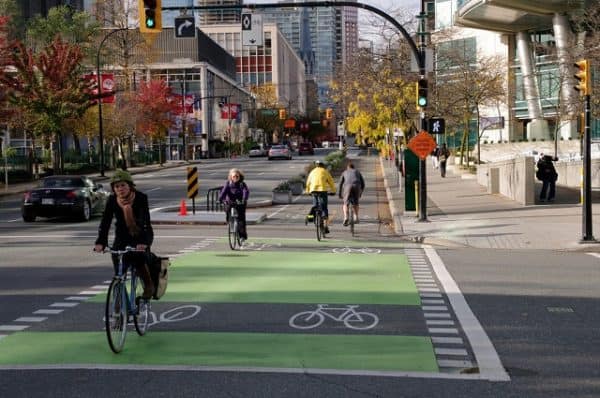

Complete streets. Catchy?
It all comes down to a tale of the tape this week, as Toronto City Hall will release its report on the much ballyhooed bike lanes along Bloor Street, put in last year as a pilot project.
But there’s more riding on the report than just a couple of strips of tarmac on one of the city’s marquee streets, since scuppering the plan, something that Mayor John Tory has said will happen if ridership numbers don’t pan out appropriately, would be not just a blow to cycling advocates across the city but a serious knock to over a decade’s worth of work and momentum-building surrounding the “complete streets” vision for Canada’s largest metropolis.
At last count, Toronto has seen 32 pedestrians and two cyclists killed in traffic this year, seven in just the past two weeks, providing further evidence if ever it were needed that public safety has to be a top priority concern for city planners. But a century of car-focused building has led to a particular mindset on how the city should function, namely, that roads are meant to allow for the speedy and efficient movement of car traffic.
And if that’s the lens through which urban planning decisions are viewed, then it stands to reason that any attempts to highlight pedestrian and cyclist safety through measures such as traffic calming, bike lanes, wider sidewalks and more pedestrian crossings will be judged by a single metric: how do they impact traffic flow?
And, following, if that’s the measure of success, then complete streets, the idea that streets are for everyone — walkers, bikers, drivers, transit-users, the young and old and mobility-impaired, too (basically, it’s municipal egalitarianism) — is dead in the water, since, most assuredly, the plan leads to slower, more constrained movement of vehicles. That’s the whole point.
Public pushback against the complete streets idea is telling, as it shows both the practical and conceptual hurdles involved in reorienting a collective mindset. Take dedicated bike lanes: everyone is forced to pay more attention or else, if you’re a pedestrian, risk getting wiped out by a bike whizzing by or, if you’re a motorist, risk plowing into one yourself.
Does it take some getting used to? Sure. Months, perhaps years — which doesn’t seem inappropriate when viewed against the backdrop of decades upon decades of car-centric indoctrinated thinking.
Notably, the conceptual shift needs adherents to a new way of talking and conversing about cities and people movement. Here’s one contributor, Joe Cooper, to the Facebook page for Biking Toronto, stating the case: “I would like to ask people to stop referring to the project taking place on Woodbine Avenue, as well as Bloor Street, as the installation of bike lanes,” writes Mr. Cooper. “What is happening on Woodbine is called a complete street and people need to being using that term all the time and drop the exclusive use of ‘bike lane.’”
Want proof that we’re not there yet? Here’s a gem of a quote from a Toronto Sun columnist who in complaining about complete streets shows she’s clearly got a ways to go before embracing the concept: “The traffic has been so horrendous this summer, it has driven me to regularly ride my bike to work.”
You don’t say?
Leave a Reply
You must be logged in to post a comment.



 Share
Share Tweet
Tweet Share
Share




Comment